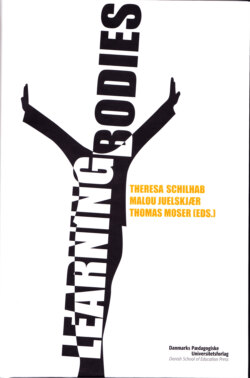Читать книгу Learning Bodies - Группа авторов - Страница 16
На сайте Литреса книга снята с продажи.
The body transplant – mismatch between sensing and execution
ОглавлениеTo take the point even further and explore the black box between sensing and execution by focussing on the actual constraints entailed by the body, let us go through another mind-bending example.
Suppose for a moment that future neurosurgeons have the skills and knowledge necessary to amputate the head of one man and restore it, fully functional, on the neck of another.
They would thus have the technical and scientific scope of knowledge about how to line up, connect and preserve neurons from different organic sources. And suppose that the paramount ideal of society was to be strong, muscular and fit. Moreover, the ideal – due to stressful living and perhaps the repulsiveness of being sweaty during exercise – was to invest as little time as possible in accomplishing that goal5. Would it then be possible, while accepting the minor inconveniences of losing one’s own body and personal signs such as tattoos and nostalgic scars, to move comfortably and agilely with the donor body? The question is: would the “transplanted” person function immediately and perfectly since all action is directed by certain cortical areas, and they have not changed. If so, we can safely conclude that the body offers nothing substantial to the effect.
Apparently, such amputations could not work out in reality. According to Collins (2000)6, the transplanted person would not be able to engage the muscles flawlessly or smoothly adapt to the change in bone structure on the spot. He would have huge amounts of information to learn about his new body, probably in the same way as someone learning how to walk on stilts. The new body would be an extension that has to become implemented before he would feel at ease with it.
What should we make of this? If one cannot have a body transfer without spending much time on adaptation, the body seems to be crucial in a more fundamental way, and these bodily constraints seem relevant to the discussion of bodily knowledge.
Naturally, the new body gives new sensations. Perhaps, the new body has lost a finger giving rise to a different configuration of the inflicted hand and the deformity is painstakingly apparent whenever grasping a cup. Or, perhaps, the feet make more contact with the ground when treading and the shoulders take up more space than before. Insofar as these bodily differences cause new experiences, immediate adaptation is unlikely. When walking by obstacles or other people in the street, the transplanted person will have to adjust to his new dimensions. Is there more to it than getting in sync with the new body?
If we granted the transplanted man a period of habituation, would he then achieve complete adjustment? In fact, he might, since he could become an expert at using the new body. But admitting perfect adjustment does not mean that he would be able to take up his “old” form of life, and that irreversibility makes the imperative of the body manifest in at least three ways.
The first and second approaches – the argument from the perspective of bodily construction and delegation of knowledge, respectively – take an individual stance on embodied cognition. Any bodily contribution depends on idiosyncratic experiences and circumstances in the life of the individual. Thus, any intra-species variability is due to ontogenetic development. The third approach, the argument from the perspective of evolution, on the other hand, is species specific in the sense that every species has it own bodily history. It claims the irreducibility of bodily cognition on the basis of evolution. In a sense, the evolutionary approach demarcates the nature and the extent of bodily cognition.
